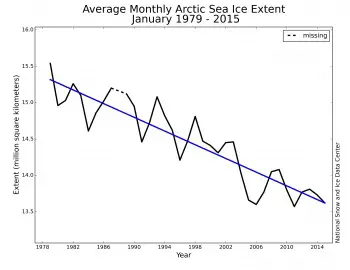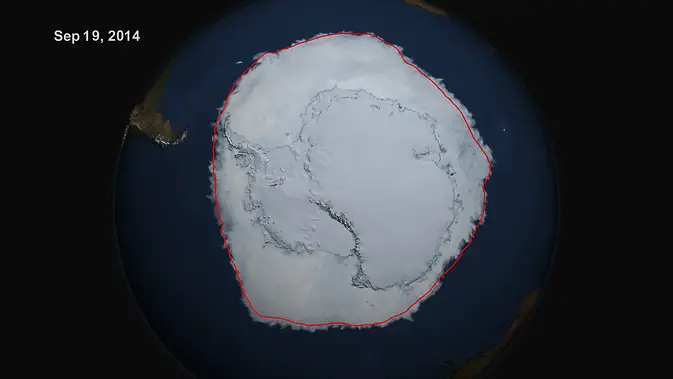Translate this page to any language by choosing a language in the box below.

Some studies show that the polar ice caps are shrinking, some say they are growing. Similarly, many glaciers are shrinking, while others are growing. The data appears mixed, at best. This is actually to be expected. The idea at that glaciers and ice caps move in lockstep is ludicrous. The earth is not a monolith, the are many reasons for local variations. Even within Antarctic sea ice, there is variation from place to place around the continent. Sea ice extent has increased somewhat in the eastern Ross Sea sector, while it has decreased in the seas around the Antarctic Peninsula. In short, Antarctic sea ice shows a nearly flat trend, but large-scale variations make the trend very inconsistent..
See Antarctic sea ice reaches record high, as Arctic hits 2014 minimum and further below, see the update for 2015, which shows the trend continuing.
Arctic sea ice extent for January was the third lowest in the satellite record. Through 2015, the linear rate of decline for January extent over the satellite record is 3.2% per decade. But, BBC News, news reports 14 December 2014 that Arctic sea ice volume holds up in 2014. "Arctic sea ice may be more resilient than many observers recognise. Two cool summers in a row have now allowed the pack to increase and then hold on to a good deal of its volume. And while the ice is still much reduced compared with the 20,000 cu km that used to stick around in the Octobers of the early 1980s, there is no evidence to indicate a collapse is imminent."
Nevertheless, many scientists say that
the rate of loss of winter Arctic ice is both substantial and a cause for
alarm.
According to NASA, Antarctic Sea Ice Reaches New Record Maximum. Sea ice surrounding Antarctica reached a new record high extent this year,
covering more of the southern oceans than it has since scientists began a
long-term satellite record to map sea ice extent in the late 1970s. The
upward trend in the Antarctic, however, is only about a third of the
magnitude of the rapid loss of sea ice in the Arctic Ocean. From the start of satellite observations in 1979 to 2014,
total Antarctic sea ice increased by about 1 percent per decade. For three consecutive Septembers from 2012 to 2014, satellites observed new record
highs for winter sea ice extent. These highs occurred while the Arctic
was seeing record lows.
Sea ice surrounding Antarctica reached a new record high extent this year,
covering more of the southern oceans than it has since scientists began a
long-term satellite record to map sea ice extent in the late 1970s. The
upward trend in the Antarctic, however, is only about a third of the
magnitude of the rapid loss of sea ice in the Arctic Ocean. From the start of satellite observations in 1979 to 2014,
total Antarctic sea ice increased by about 1 percent per decade. For three consecutive Septembers from 2012 to 2014, satellites observed new record
highs for winter sea ice extent. These highs occurred while the Arctic
was seeing record lows.
Antarctic Sea Ice Officially Hits New Record Maximum. "Antarctic sea ice hit its annual winter maximum on Sept. 22, 2014 reaching a record area of 7.76 million square miles, the National Snow and Ice Data Center (NSIDC) announced. Antarctic sea ice extent for Sept. 22, 2014 was 7.76 million square miles. The orange line in the figure shows the 1981-2010 average extent for that day, and the black cross indicates the geographic South Pole. Click image to enlarge. Credit: National Snow and Ice Data Center.
That maximum extent was 595,000 square miles above the 1981-2010 average extent, the NSIDC said in a statement, and broke the consecutive records set in 2012 and 2013. The record had been expected and follows a trend over the last three years of anomalously high winter ice extents around the southernmost continent - a trend that provides a stark contrast to the inexorable decline of Arctic sea ice, which it's sixth lowest summer extent on record last month. (Seasons in the Northern and Southern Hemispheres run opposite each other.)"
Although this report was released in 2014, it has resurfaced in the news in November 2015 at the 2015 report came in and show the trend continued. See this page and look for this section:
2015 Antarctic Maximum Sea Ice Extent Breaks Streak of Record Highs
The
sea ice cover of the Southern Ocean reached its yearly maximum extent on
Oct. 6. At 7.27 million square miles (18.83 million square kilometers), the
new maximum extent falls roughly in the middle of the record of Antarctic
maximum extents compiled during the 37 years of satellite measurements -
this year's maximum extent is both the 22nd lowest and the 16th highest.
More remarkably, this year's maximum is quite a bit smaller than the
previous three years, which correspond to the three highest maximum extents
in the satellite era, and is also the lowest since 2008.
Then click read the full article for an interesting video on the subject by on e of the scientists.
In 46 years of records, more snow covered the Northern Hemisphere this
fall than any other time. It is a very surprising result, especially when
you consider temperatures have tracked warmest on record over the same
period.
Data from Rutgers University Global Snow Lab show the fall
Northern Hemisphere snow cover extent exceeded 22 million square kilometers,
exceeding the previous greatest fall extent recorded in 1976.
Ways to save money AND help the environment:
Eat healthier AND save money: Instant Pot Duo Crisp 11-in-1 Air Fryer and Electric Pressure Cooker Combo with Multicooker Lids that Fries, Steams, Slow Cooks, Sautés, Dehydrates
Save water AND money with this showerhead adapter, it lets the water flow until the water is hot, then shuts off water flow until you restart it, ShowerStart TSV Hot Water Standby Adapter
Protect your health with these:
Mattress Dust mite-Bedbug protector, 100% Waterproof, Hypoallergenic, Zippered
Handheld Allergen Vacuum Cleaner with UV Sanitizing and Heating for Allergies and Pet, Kills Mite, Virus, Molds, True HEPA with Powerful Suction removes Hair, Dander, Pollen, Dust,
Immune Support Supplement with Quercetin, Vitamin C, Zinc, Vitamin D3
GermGuardian Air Purifier with UV-C Light and HEPA 13 Filter, Removes 99.97% of Pollutants
5 Stage Air Purifier, Features Ultraviolet Light (UVC), H13 True Hepa, Carbon, PCO, Smart Wifi, Auto Mode, Quiet, Removes 99.97% of Particles, Smoke, Mold, Pet Dander, Dust, Odors
Interesting Reads:
THE PREPPER'S CANNING & PRESERVING BIBLE: [13 in 1] Your Path to Food Self-Sufficiency. Canning, Dehydrating, Fermenting, Pickling & More, Plus The Food Preservation Calendar for a Sustainable Pantry
The Backyard Homestead: Produce all the food you need on just a quarter acre! Paperback
The Citizens' Guide to Geologic Hazards: A Guide to Understanding Geologic Hazards Including Asbestos, Radon, Swelling Soils, Earthquakes, Volcanoes
The Uninhabitable Earth: Life After Warming
Book: The Sixth Extinction: An Unnatural History Paperback